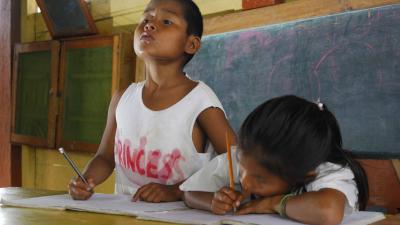
The Young Lives team in Peru presented preliminary findings from the fourth round of the Young Lives household and child survey on 17 March 2015.
By following the same families for eleven years it has been possible to gather valuable information about the opportunities and challenges facing children and young people in Peru. This round of Young Lives data collected in late 2013 allows us to compare outcomes for children from the Younger Cohort (aged 11 to 12) with the Older Cohort children when they were both the same age in 2006. While the younger children have more opportunities than their older peers at the same age, those growing in rural areas, in the poorest areas or from an indigenous background face an environment where institutions are weak and there are fewer opportunities. In general, we find that access to basic services has improved, reflecting Peru's economic growth: the percentage of households with access to electricity rose from 60% in 2002 to 83% in 2009 and to 94% in 2013. However, we also found that many households still do not have running water or access to the internet. Furthermore, although the coverage of various services has expanded in rural areas, services are often of lower quality than in urban areas.
We found that almost all children were attending primary school, but grade repetition rose from 12% in 2009 to 30% in 2013, a phenomenon more pronounced in poor communities of the Andes and Amazon areas. Similarly, the 12-year-olds in 2013 performed better in our vocabulary tests than the Older Cohort children at the same age (in 2006) but are still scoring below the international standard level, with poorer results among rural and indigenous children. Among the Older Cohort – aged 18 to 19 during the survey, 4 in 10 were attending post-secondary education (close to the average for Latin America) but the poorest young people are less likely to complete high school and go to university than their peers.
A positive finding was that levels of stunting had fallen among the younger children to about 21%, half that observed in Older Cohort at age 12 (42%); this is consistent with the national trend. However, malnutrition of children and adolescents in the Andes and Amazon regions is significantly higher than their peers from more advantaged backgrounds.
With the official release of more findings from the fourth round of the household survey, we hope to encourage other researchers and stakeholders to use the data from Young Lives, so that this information will serve to improve public policy for children and young people.
See more at: http://www.ninosdelmilenio.org/novedades/informe-de-la-cuarta-ronda-de-encuestas-de-ninos-del-milenio/
The Young Lives team in Peru presented preliminary findings from the fourth round of the Young Lives household and child survey on 17 March 2015.
By following the same families for eleven years it has been possible to gather valuable information about the opportunities and challenges facing children and young people in Peru. This round of Young Lives data collected in late 2013 allows us to compare outcomes for children from the Younger Cohort (aged 11 to 12) with the Older Cohort children when they were both the same age in 2006. While the younger children have more opportunities than their older peers at the same age, those growing in rural areas, in the poorest areas or from an indigenous background face an environment where institutions are weak and there are fewer opportunities. In general, we find that access to basic services has improved, reflecting Peru's economic growth: the percentage of households with access to electricity rose from 60% in 2002 to 83% in 2009 and to 94% in 2013. However, we also found that many households still do not have running water or access to the internet. Furthermore, although the coverage of various services has expanded in rural areas, services are often of lower quality than in urban areas.
We found that almost all children were attending primary school, but grade repetition rose from 12% in 2009 to 30% in 2013, a phenomenon more pronounced in poor communities of the Andes and Amazon areas. Similarly, the 12-year-olds in 2013 performed better in our vocabulary tests than the Older Cohort children at the same age (in 2006) but are still scoring below the international standard level, with poorer results among rural and indigenous children. Among the Older Cohort – aged 18 to 19 during the survey, 4 in 10 were attending post-secondary education (close to the average for Latin America) but the poorest young people are less likely to complete high school and go to university than their peers.
A positive finding was that levels of stunting had fallen among the younger children to about 21%, half that observed in Older Cohort at age 12 (42%); this is consistent with the national trend. However, malnutrition of children and adolescents in the Andes and Amazon regions is significantly higher than their peers from more advantaged backgrounds.
With the official release of more findings from the fourth round of the household survey, we hope to encourage other researchers and stakeholders to use the data from Young Lives, so that this information will serve to improve public policy for children and young people.
See more at: http://www.ninosdelmilenio.org/novedades/informe-de-la-cuarta-ronda-de-encuestas-de-ninos-del-milenio/


